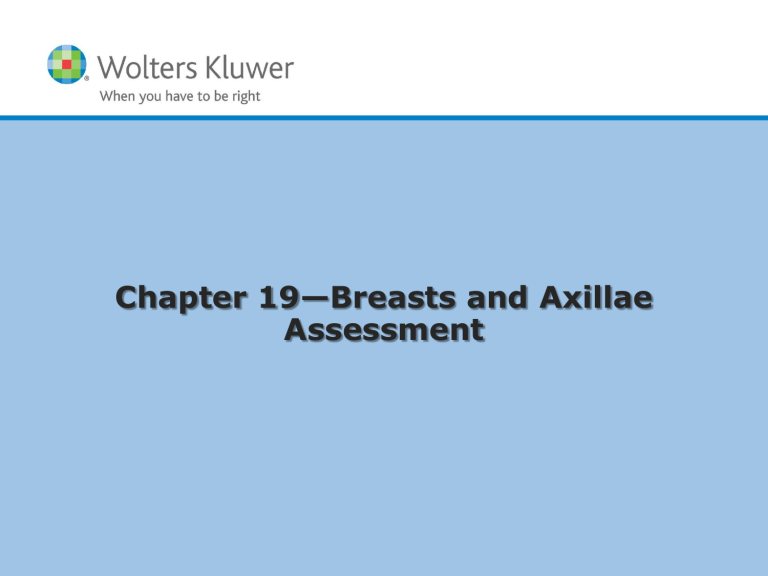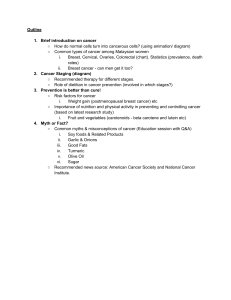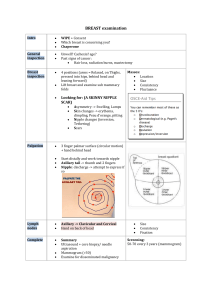
Chapter 19—Breasts and Axillae Assessment Copyright © 2015 Wolters Kluwer Health | Lippincott Williams & Wilkins Structure and Function #1 Landmarks o Identification strategies 4 quadrants Breast structures o Nipple; areola; Montgomery glands o Fibrous tissue: supportive Cooper ligaments (connect to the tissue surrounding the chest muscles. These ligaments maintain the shape and structure of the breasts) o Glandular tissue: 15 to 20 lobes Each lobe: 20 to 40 lobules Acini cells: milkproducing; lactiferous ducts Copyright © 2019 Wolters Kluwer • All Rights Reserved Structure and Function #2 Axillae and lymph nodes o Lateral axillary (brachial) nodes o Central axillary (midaxillary) nodes o Posterior axillary (subscapular) nodes o Anterior axillary (pectoral) nodes Copyright © 2019 Wolters Kluwer • All Rights Reserved Lifespan Considerations o Pregnancy Colostrum: first form of breastmilk that is released by the mammary glands after giving birth. It's nutrientdense and high in antibodies and antioxidants to build a newborn baby's immune system o Tanner staging: sexual Maturity Rating (SMR), is an objective classification system that providers use to document and track the development and sequence of secondary sex characteristics of children during puberty. o Menarche: the first menstrual period (usually ages of 10 and 16). o Gynecomastia: breast gland tissue caused by an imbalance of the hormones estrogen and testosterone, that occurs in men. Copyright © 2019 Wolters Kluwer • All Rights Reserved Tanner Staging Copyright © 2019 Wolters Kluwer • All Rights Reserved Lifespan Considerations #2 Cultural variations and health disparities o Environmental factors, socioeconomic conditions, nutrition, access to preventive healthcare influence timing of puberty o Black or African American females almost 40% more likely to die from breast cancer compared to White females Copyright © 2019 Wolters Kluwer • All Rights Reserved Urgent Assessment Conditions requiring further investigation o New breast lump/Swelling o Existing lump with changes o Axillary lump o Skin irritation or dimpling o Nipple discharge o Nipple retraction/inverted nipple o Breast or nipple pain o Breast cancer can mimic other inflammatory conditions. Copyright © 2019 Wolters Kluwer • All Rights Reserved Subjective Data #1 Breast discomfort, masses or lumps, nipple discharge Breast surgeries Menstrual, pregnancy, and lactation history Hormone replacement therapy, contraceptive use that emits hormones Personal history of breast trauma and self-care behaviors Family history of breast cancer, other breast disease, confirmed BRCA1 or BRCA2 mutation Copyright © 2019 Wolters Kluwer • All Rights Reserved Subjective Data #2 Risk reduction and health promotion o Health goals Increase proportion of mothers who breastfeed. Reduce female breast cancer death rate by 10%. Reduce late-stage female breast cancer by utilizing genetic counseling for at-risk for breast cancer. Breast self-examination (BSE) The best time to do a monthly breast self-exam is about 3 to 5 days after your period starts. Do it at the same time every month. Your breasts are not as tender or lumpy at this time in your monthly cycle. Mammograms: Women should get mammograms every year. Women 55 and older can switch to a mammogram ever other year. Copyright © 2019 Wolters Kluwer • All Rights Reserved Objective Data #1 Comprehensive physical assessment o Inspection o Palpation Patient supine with arm extended upward Palpate breasts with both the flat of your hand and fingers Follow systematically, in a circular pattern around the nipple or along the radial lines (simulate a clock) or vertical segments and feel the entire breast, including the tail near the axilla. Feel the areola and nipple for tenderness; nodules; nipple palpation Copyright © 2019 Wolters Kluwer • All Rights Reserved Objective Data #2 Comprehensive physical assessment—(cont.) o Male breasts (still assess for breast cancer) o Additional techniques Mammography, ultrasound, MRI, biopsy o Genetic Testing: Certain mutations in the BRCA genes make cells more likely to divide and change rapidly, which can lead to cancer. All women have BRCA1 and BRCA2 genes, but only some women have mutations in those genes. About 1 in every 500 women in the United States has a mutation in either her BRCA1 or BRCA2 gene. Copyright © 2019 Wolters Kluwer • All Rights Reserved Critical Thinking Laboratory and diagnostic testing: mammography; ultrasound Diagnostic reasoning: nursing diagnoses; outcomes; interventions o Outcomes (partial list) Patient returns to previous social involvement. Patient performs BSE monthly. o Interventions (partial list) Teach BSE, encouraging monthly performance. Allow for privacy during breast examination. Copyright © 2019 Wolters Kluwer • All Rights Reserved







